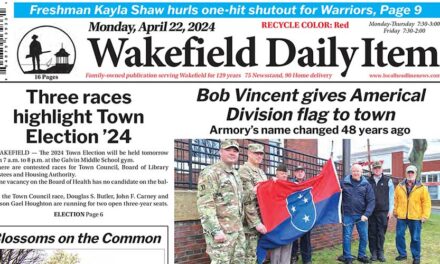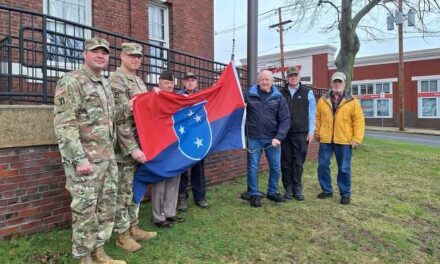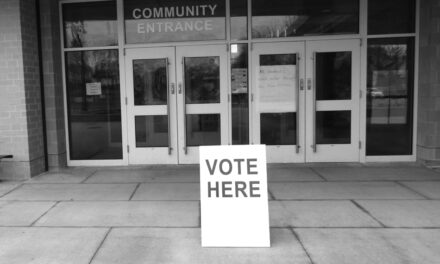By MARK SARDELLA
WAKEFIELD — The town now has a new flag policy, but the vote at last night’s Town Council meeting came with a moment of friction between Chair Mehreen Butt and Councilor Edward Dombroski.
The impetus for the new policy dates back to April, when the Wakefield Human Rights Commission approached the Town Council about flying the Pride and Juneteenth flags from various flagpoles around town.
The Town Council agreed to the request and asked Town Counsel Thomas Mullen to make the necessary revisions to the town’s flag policy. Meanwhile, the town’s Veteran’s Advisory Board made it clear that they did not want any flag other than the POW-MIA flag to be flown on the same pole with the United State flag.
The veterans suggested that the town install additional poles from which flags representing different causes could be flown separately from the American flag.
At its next meeting in April, the Town Council decided to delay taking any action pending the resolution of a U.S. Supreme Court case involving the city of Boston.
In that case, the city had allowed one of its three flagpoles in front of City Hall to be used by any group using City Hall Plaza for an event. The city had conceded that City Hall Plaza was a public forum and had allowed the Pride Flag and a number of other flags to be flown. The city had never refused to fly a flag until activist Harold Shurtleff asked to fly what he called the Christian flag. Boston said no, out of fear of running afoul of the Establishment Clause of the First Amendment, which prohibits the government from recognizing the establishment of a religion.
But in its decision issued last month, the Supreme Court held that Boston had used the flagpole as a public forum and therefore had to allow it to be open to all comers.
On the other hand, the Supreme Court indicated that the city could declare that the flagpole is not a public forum but is strictly an organ of government speech that only flies flags consistent with the sentiments and values of the city. And if people don’t like it, they can vote city officials out of office.
That Supreme Court ruling was, in essence, the basis of the new flag policy that Mullen drafted and brought before the Town Council last night. The policy applies to all flagpoles on town property that come under the control of the Town Council.
The new policy states, in part:
“Town flagpoles are not intended as a forum for free expression by the public. Rather, the decisions of the Town Council concerning which flags to fly, and when, and from which flagpoles, are intended as an expression of official Town sentiment. Flags permitted by vote of the Town Council to be flown from any Town flagpoles may, or may not, have some connection with groups using space on Town property (such as those participating in a parade on a public way, or renting space in the Americal Civic Center for a meeting, or using an area of the Common for festivities), but in each instance the discretionary choice of the Town Council to fly or not to fly a flag reflects the will of the Town government, and no group or individual shall have a right to dictate that choice.”
The policy further states, “The flag of the United States shall regularly be flown during daylight hours from at least one flagpole at each Town facility that has one or more flagpoles.”
In addition, the policy says that “No flag or banner may be displayed above the flag of the United States, and no flag other than the POW-MIA flag shall be displayed below the American flag, on any Town flagpole.”
Aside from the American flag and the POW-MIA flag, which are to be regularly displayed as previously described, the policy says that “No other flag or banner shall be flown from any Town flagpole covered by this policy without the express, prior vote of the Town Council, which vote may establish the number and location(s) of such flags or banners, and the period(s) of time when they shall be flown, provided that no flag or banner may be longer or wider than the flag of the United States that is flown with it.”
Mullen explained that this meant that the American flag and POW-MIA flag shall be flown from poles at all town facilities. Any other flags, he said, would have to be flown from separate poles, if approved by the Town Council.
Town Councilor Edward Dombroski posed several questions to Mullen in an attempt to get clarity regarding certain aspects of the policy. Ultimately, Dombroski said that he was not comfortable with the fact that a majority of four on the Town Council would get to decide what constituted “official town sentiment” in terms of what is represented on town flagpoles. He noted that the Town Council has no protocol in place for deciding what “official town sentiment” is.
Dombroski said that he would prefer to simplify matters by having a policy that allows only the United States flag and the POW-MIA flag to be flown from town-owned poles.
Mullen said that he did not disagree with Dombroski’s point. He said that the Town Council could decide which flags to fly or it could simply limit it to just the American and POW-MIA flags.
At this point Town Council chair Mehreen Butt noted that a motion had already been made and seconded.
“I politely disagree with you, Councilor Dombroski,” she said. “This is why we were elected to make these decisions. The body of seven of us can decide and we vote with our decisions and people can vote us out if they don’t agree with what we consider to be an expression of welcoming in our town.”
Butt then called for the vote. When Dombroski attempted to speak again, she cut him off. “I called the vote,” she said. “I called it.”
Dombroski countered, “So if you want to shut down discussion, that’s fine.”
Butt retorted that Dombroski has already spoken “three times.”
In the end, the policy passed with only Dombroski opposed. He reiterated that he was opposed because the Town Council lacks any policy on how they would decide which flags to allow or deny.
“I think that’s an important piece to this,” he said.




